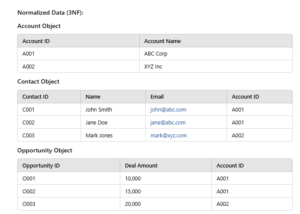People First Playbook – Overview
by Jackson Hull
Can we measure "people first" form and function in Salesforce delivery?
When engaging in a Salesforce project, the importance of system design cannot be overstated. Ensuring that the data is organized, accurate, and free from redundancy is crucial for maximizing the efficiency of your system and enhancing the overall user experience. One of the most fundamental aspects of organizing data is normalization, a process that ensures a well-structured and efficient database. But normalization doesn’t just stop at technical procedures—it should also be aligned with the People First Method, combining technical expertise with the human-centered, soft skills that elevate Salesforce projects.
What is Normalization?
Normalization is a critical process in database design that helps reduce duplication, improve data accuracy, and create a structure that is both efficient and scalable. The process of normalization organizes data into tables, ensuring that relationships between the data are properly defined and data integrity is maintained.
In database design, there are several levels of normalization, known as “normal forms” that follow the pattern of good, better, best.
- First Normal Form (1NF) involves eliminating duplicate columns and organizing data into tables
- Second Normal Form (2NF) ensures that all non-key attributes are fully dependent on the primary key
- Third Normal Form (3NF) goes a step further by removing transitive dependencies—relationships between non-key columns.
Achieving 3NF ensures a well-structured, accurate, and efficient database. If you look at the image below you will see a design that achieves 3NF. Instead of consolidating all information into a single table, the data is organized into a structured, scalable, and purpose-specific table design, ensuring consistency and ease of querying.

When applied to Salesforce projects, this means fewer data inconsistencies and improved performance. But while normalization focuses on the technical side of things, it’s important not to overlook the human side of project design. People-First Formation uses a similar paradigm and adapts the principles of database normalization to emphasize people first aspects including:
-
- First People-First Form (PF1) represents the technically sufficient solution—for example, a list button and flow that simply deletes selected records.
- Second People-First Form (PF2) incorporates considerations for users and non-technical aspects. For instance, enhancing the flow by checking whether records have been selected, adding validation screens, and updating the flow description to clarify revised capabilities or purpose. An important note is this People-First Form seeks to enable both end users and future administrators along the lifecycle of the technical component (i.e. a Flow.)
- Third People-First Form (PF3) emphasizes superior user experience (UX) for use in a variety of contexts and form factors, confirming security access to data and components, re-entry context for fractional or paused work, and robust signaling/error handling. Examples include adding a loop to count how many records will be deleted for signaling the user (especially on destructive actions like deletes, merges, and edits), implementing a data table to display the records being deleted for context confirmation, incorporating specific error messages for better signaling, and documenting the solution in a Solution Design Document to ensure clarity for the client and future administrators.
An important consideration as we progress toward the Third People-First Form is the strategic integration of AI. AI can enhance many of the People First principles we advocate for by considering other admins and improving documentation. For example, leveraging Einstein to generate detailed descriptions of Flows allows administrators to maintain a clear and comprehensive record of their contributions to the organization, ensuring transparency and ease of future maintenance.
The People First Method: Bridging the Technical with the Human Element
In most Salesforce projects, admins, consultants, and developers often focus exclusively on the technical aspects. While the technical is critical for ensuring the system works properly, there is another layer to consider—how the end-users interact with the system, and how the design of the database can better serve them.
The People First Method emphasizes the importance of soft skills and human-centered thinking in technical projects. Decades of experience have shown that building systems with a focus on the people who will be using them leads to better outcomes. This approach is especially beneficial when working with Salesforce, as the platform’s complexity requires a combination of technical expertise and a deep understanding of the users’ needs and behaviors.
All of our teams are trained and apply this method in their work and seek to achieve Third People First Form in project delivery. Salesforce Partners can enhance their team, reduce their risk, and grow their business by engaging DevPod for Salesforce Partners to support their goals.
Related Articles
Related
Why Salesforce Partners Should Invest in Artifacts
SF Ben recently published an article called How to Avoid Bad Salesforce Partners: The Three-Question Test. This article is for delivery leads and emphasizes that the success of Salesforce projects hinges more on intangible skills rather than technical skills. As a...
When Salesforce Projects Go Awry: Lessons for Salesforce Implementation Partners
As a Salesforce implementation partner, your role in navigating digital transformation complexities is pivotal to client success and your reputation. Over the years, I’ve seen how the lessons from both successful and failed projects can help implementation partners...
